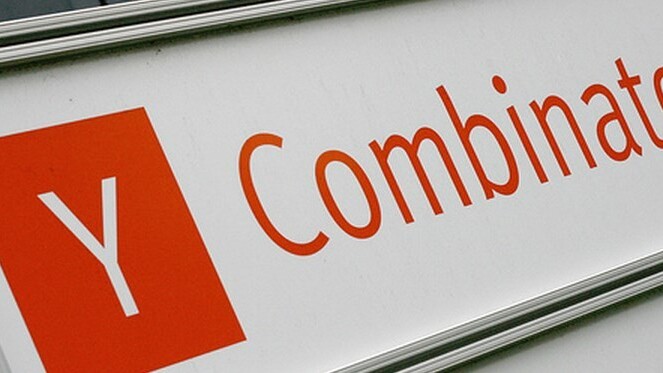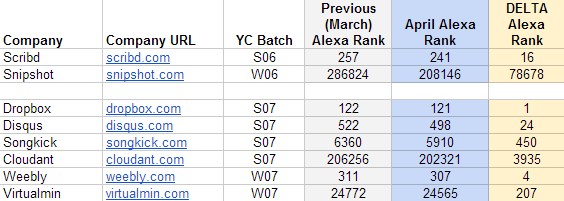
Y Combinator (YC) is among the world’s leading seed-funding and startup accelerator groups. They have funded companies that have gone on to massive success, such as Dropbox and Disqus, and myriad others that have run the gamut from closing, to medium-strength exits.
Danielle Morrill of Referly is working to better quantify the current startup and venture capital worlds. One of her recent projects is a spreadsheet that tracks the traffic ranking of a number of YC companies, the 112 that currently rank above the 250,000 mark on Alexa.
Oh dear, I can hear you saying, Alexa. I understand your pain. However, while Alexa isn’t much good at figuring out precisely how large a website truly is, it is in fact somewhat good at tracking progression. This is to say that if a site is ranked 50 or 57 doesn’t mean overmuch, but a movement from 100,000 on the list to 4,500 does.
Alexa ranks are top-down, in that a lower rank means that a site is larger. You want to become number 1. Also important to keep in mind: Alexa rankings are in a way logarithmic. To get from 100,000 to 99,999 might be a thousand uniques per month. But to move from 100 to 99 might require 10 million.
Let’s see what we can find out looking at publicly available data to see how things are going in Y Combinator-land.
Alive
For a rawer look at Y Combinator-backed companies, YClist has your data. Here’s their breakdown: Dead: 46. Exited: 51. Active: 329. Given that active figure, we can ascertain that roughly one-third of active YC firms are currently above the 250,000 mark on Alexa’s rankings.
For reference, The Next Web is currently ranked 1,684 on Alexa, and has monthly pageviews north of 10 million. I’m not sure on the current number we have in our ad kits, so I’ll leave it at that.
Put another way, about one-third of active YC firms have meaningful traffic on a monthly basis. A new company might not be too worried about sitting beneath the 250,000 mark, but a company that has launched and is working to drive usership would want to be a bit above that mark, and trending upward.
This brings us to Danielle’s data. She did all the leg work on this, and then graciously shared it with TNW. We’re grateful. Her analysis can be found here. What we’ll do next is tease out a few interesting nuggets from the data, to see just what we can learn from some basic figures.
Note: Companies that exited and were then shuttered, perhaps through an acquihire won’t be found below. Thus, when we find a specific correlation, we have to keep in mind that we are speaking in broad strokes, and not with perfectly clean data. We’re simply trying to have some fun with numbers and learn a bit. That’s it.
Growth
Here are the leaders among the 112 companies that have the highest delta – change – in their Alexa rankings down – indicating growth – ranked from leader, south:

What you’ll quickly notice is that most of the firms that have the highest Alexa delta are younger YC firms. Except Snipshot, which is a special case. What happened there? The service is effectively over, its founders having joined Facebook. It’s for sale on Flippa. Apparently Zuckerberg mentioned it on Facebook. Spike!
For the rest of the top 25, it’s the game of the younger classes. Which makes sense: the smaller the firm, the easier it is to bust through the rankings; recall that the larger your Alexa number, the easier it is to move up.
Let’s demonstrate that with the deltas of a few companies that you know. The firms with the lowest delta on the list are:
Dropbox
- Delta: 1
- Ending rank: 121
- YC Batch: Summer 2007
Weebly
- Delta: 4
- Ending rank: 307
- YC Batch: Winter 2007
Scribd
- Delta: 16
- Ending rank: 241
- YC Batch: Summer 2006
Airbnb
- Delta: 22
- Ending rank: 2,690
- YC Batch: Winter 2009
Disqus
- Delta: 24
- Ending rank: 498
- YC Batch: Summer 2007
These companies are alike: They are founded in the early days of Y Combinator, have low – high! – Alexa rankings, and their delta figures imply steady growth into their period of maturation.
A few more observations:
- Only one firm from the Winter 2012 batch is in the top 25,000 websites online. This compares interestingly to four firms from the Summer 2012 batch that have passed that mark.
- The Summer and Winter 2011 batches have one per group in the top 25,000.
- The older the class the fewer active companies: Both Winter and Summer 2006 have but one firm apiece that remains active in the top 250,000. However, as one of those two is Scribd, that’s not a terrible record.
- For comparison, the 2012 classes have more than 25 between them in the top 250,000.
YC companies that do make it stand alone enterprises tend to do well. For fun, here are the YC companies that are above the 250,000 mark from 2006 and 2007:

That’s an impressive list of firms. Naturally, we saw many of these companies in our above tally. The difficult part with this information is that certain companies have higher trafficked websites by nature; a company that vends a service through a non-Web application, say, would have dramatically fewer hits to its homepage than another sort of company. As stated before, we’re working in very large movements.
In comparison, there appears to be just three firms from the Winter and Summer 2008 classes still active, with the possible exception of a name change skewing the data. A failure? That year gave birth to Heroku, which Salesforce.com purchased for $212 million.
Conclusion
The above data is situational and confusing. It’s always dangerous to over-derive from data that just can’t take the pressure. That in mind, here are a few thoughts:
- Y Combinator has shown a consistent ability to find, and fund companies that sell for large figures. It also has demonstrated a capability to find and fund firms that become giants, heading towards the public markets.
- Still, acceptance into YC isn’t a ticket to anything; there are nearly as many defunct YC firms as excited companies. And many that are placed in the ‘active’ category might in fact be Zombie startups, to use Danielle’s term.
- It will be exceptionally interesting to see if there is a rolling ‘shake out or up’ of YC firms that plays itself out with each cycle. As 2008 is a five years past, we have a better view of its batch’s success; we have even more data on the 2006 classes, and the least on the most recent 2012 class, which was its Summer batch. Perhaps what we see in 2006, 2007 and 2008 will be similar to what we see with 2010, 2011, and 2012.
- If the past is model for the present: there will be a handful of massively successful 2012 companies, a number that linger for some time before they are shuttered, and several that are picked up in moderate fashion.
Which is to say that being a startup in YC is akin to building a company anywhere else. That said, the overall failure rate of YC companies is lower than average outside of its walls. This is a combination of its filtering process, provided capital and connections and the like. But you can fail anywhere, which is something to keep in mind.
Top Image Credit: Paul Miller
Get the TNW newsletter
Get the most important tech news in your inbox each week.





